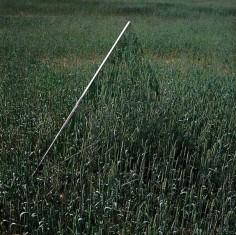FRANCISCO INFANTE-ARANA
Франциско Инфанте Арана
source: saatchigallery
“In my artistic practice, the principle of a phenomenon corresponded (and did even before this) to the idea of the infinite. In its context, I was interested in the theme of the cosmos. Its infinite facilities, its paradoxical possibilities, its reality of the impossible”.
Born in 1943
Francisco Infante-Arana was one of the leaders of Russian Kinetic art. In 1962, Infante-Arana and Lev Nussberg founded an artists’ cooperative, which developed the ideas of constructivism and formed the core of the “Movement” group. Beginning in the mid-1970s, Infante-Aranta began to develop the idea of the artifact, which combined the creation of an object with an artistic geometric form, the establishment of the object in its surrounding environment and the fixing of an altered landscape as an artifact onto the camera. Having created this complicated system of landscapes, the artist did not resort to montage (photoshop would only be created thirty years later), but used the basic technological skills to create objects and special constructions, as well as the resulting footage of the artifact-objects. He currently lives and works in Moscow.
.
.
.
.
.
.
.
source: talkingtothelisteningtree
Francisco Infante-Arana (b.1943) produced work as a kinetic artist in the 1960s. Making contributions to the land art movement, he built installations in the natural environment. These installations, which could be seen as interventions, included aspects of reflection. He refers to these works as artifacts, “assemblages reliant upon the effects of reflectivity, ambiguity and interactivity that often appeal to geometric traditions of the Russian avant garde”. His works, which are recorded in the form of these photographic images, capture the juxtaposition between the natural environment and his artificial intervention. They hint towards the numerous oppositions that can be found in the world. Here the intervention becomes an extension of the natural environment. It is difficult to see where the natural environment ends and the intervention begins. This brings the elements together in a more harmonious manner. This piece captures multiple mini scenes within the actual scene. The mirrors become frames within the frame, capturing multiple images with one shot. The natural reflective quality of the water adds to the reflective quality of the mirrors, capturing beautiful patterns of natural light. Both mirrors and photography can be seen to create a link to the real, yet they can equally be seen to displace reality. By combining the two, this relationship becomes more apparent within the works.
.
.
.
.
.
.
.
source: loreakmendian
Infante-Arana nació en un suburbio de Moscú (1943). Comenzó su carrera como artista cinético, siempre muy en contacto con la naturaleza. Son destacables sus aportaciones al Land Art durante su primera época. En 1964 formó junto a otros artistas, el colectivo DVIZHENIYE GROUP, (también conocido como Movement Group), uno de los referentes de la vanguardia rusa de la segunda mitad del s.XX. Actualmente centra su trabajo en la fotografía, pero sin dejar su fascinación por la naturaleza y por la geometría. Infante-Arana vive y trabaja en Moscú con su mujer, la también artista NUNNA GORIUNOVA, con la que formó otro grupo artístico en 1970 llamado ARGO y con sus dos hijos, los también artistas Platon y Pakhito (me encanta este ultimo nombre).
.
.
.
.
.
.
.
source: bpublicsounds
러시아 작가 Francisco Infante-Arana의 거울을 이용한 Land art(대지미술)입니다. 대지미술이란 미술관 밖에서 자연 그 자체를 재료로 이루어지는 환경미술로, 미니멀 아트의 영향에서 물질로서의 예술을 부정하려는 경향과 반문명적인 문화 현상이 뒤섞여 탄생했습니다. 즉, 자연이 미술관이며 작품이 자연입니다. 우리가 중학교때 학습한 내용들이죠.
대지미술은 자연의 소재, 표현의 방법과 작가의 성향에 따라 매우 다양한 예술인데요, 이 작가는 거울을 활용해서 광범위한 표현과 착시효과를 일으키며 좀 더 작품에 흥미를 부여했습니다. 위의 작품엔 인위적인 조작없이 땅이 하늘에 솟아있고 하늘이 땅에 박혀있네요.흥미롭지 않나요!? 무튼 문명에 의해 위협받는 자연의 아름다움과 인공물의 조화가 아름답군요. 모든 자연경관과 현상들이 화폭이 되는 대지미술, 감상해보시죠!
.
.
.
.
.
.
.
source: arhinovosti
Некоторые люди думают, что во времена Советского Союза не было никакой альтернативы портретам Ленина фотографиям “с передовой трудовых будней” и другим образцам коллективно – принудительного искусства. Но это не так. Пример – творчество Франциско Инфантэ-Арана (Francisco Infante-Arana) – художника, фотограф.


